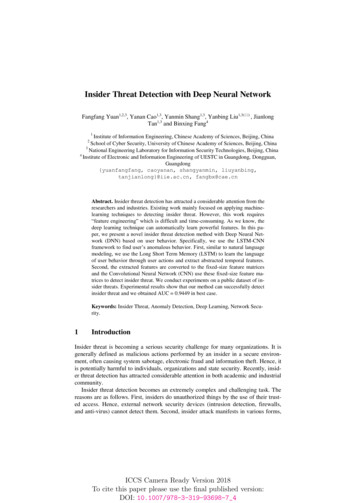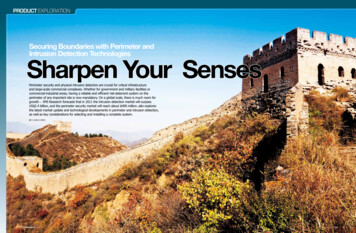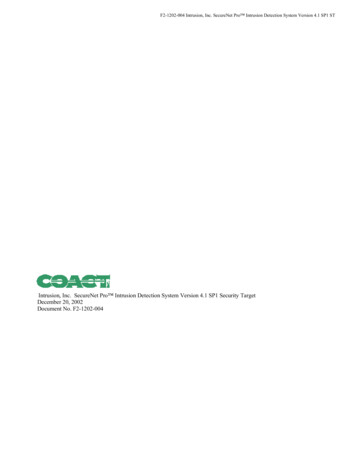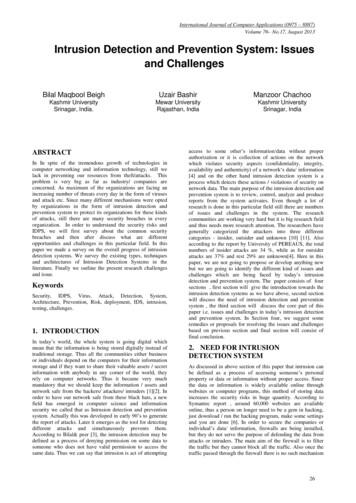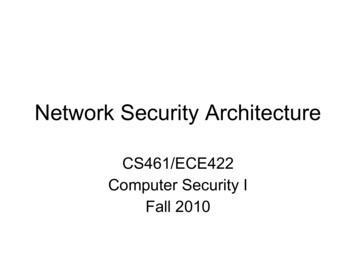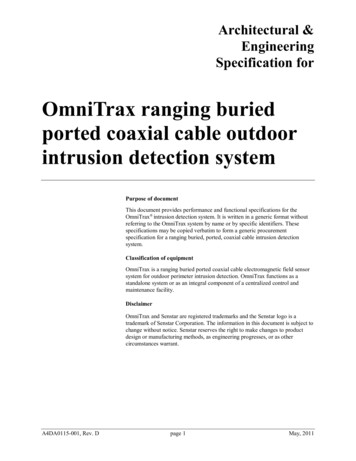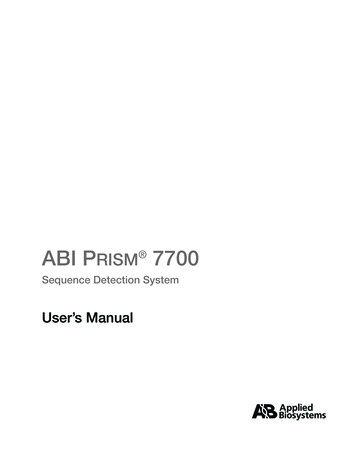
Transcription
ABI PRISM 7700Sequence Detection SystemUser’s Manual
Copyright 2000, Applied BiosystemsFor Research Use Only. Not for use in diagnostic procedures.Printed in the U.S.A.Notice to Purchaser: Limited LicenseA license under U.S. Patents 4,683,202, 4,683,195 and 4,965,188 or their foreign counterparts, owned by Roche Molecular Systems, Inc. andF. Hoffmann-La Roche, Ltd. (“Roche”), for use in research, has an up-front fee component and a running-royalty component. The purchase price of theTaqMan Allelic Discrimination Demonstration Kit (P/N 402874) includes limited, non-transferable rights under the running-royalty component to useonly this amount of the product to practice the Polymerase Chain Reaction (“PCR”) and related processes described in said patents solely for the researchactivities of the purchaser when this product is used in conjunction with a thermal cycler whose use is covered by the up-front fee component. Rights tothe up-front fee component must be obtained by the end user in order to have a complete license. These rights under the up-front fee component may bepurchased from Applied Biosystems or obtained by purchasing an authorized thermal cycler. Further information on purchasing licenses to practice thePCR process may be obtained by contacting the Director of Licensing at Applied Biosystems, 850 Lincoln Centre Drive, Foster City, California 94404or at Roche Molecular Systems, Inc., 1145 Atlantic Avenue, Alameda, California 94501.Authorized Thermal Cycler NoticeThis instrument, Serial No. , is an Authorized Thermal Cycler. Its purchase price includes the up-front fee component of a license under thepatents on the Polymerase Chain Reaction (PCR) process, which are owned by Roche Molecular Systems, Inc. and F. Hoffman-La Roche Ltd., to practicethe PCR process for internal research and development using this instrument. The running royalty component of that license may be purchased fromApplied Biosystems or obtained by purchasing Authorized Reagents. This instrument is also an Authorized Thermal Cycler for use with applicationslicenses available from Applied Biosystems. Its use with Authorized Reagents also provides a limited PCR license in accordance with the label rightsaccompanying such reagents. Purchase of this produce does not itself convey to the purchaser a complete license or right to perform the PCR process.Further information on purchasing licenses to practice the PCR process may be obtained by contacting the Director of Licensing at Applied Biosystems,850 Lincoln Centre Drive, Foster City, California 94404.Except as provided above, no rights are conveyed expressly, by implication or estoppel to any patents on any other process, including but not limited to5 nuclease assays, or to any patent claiming a reagent or kit.ABI PRISM, AmpErase, MicroAmp, and Applied Biosystems are registered trademarks of Applera Corporation or its subsidiaries in the U.S. and certainother countries.ABI and Primer Express are trademarks of Applera Corporation or its subsidiaries in the U.S. and certain other countries.GeneAmp and TaqMan are registered trademarks and AmpliTaq Gold is a trademark of Roche Molecular Systems, Inc.All other trademarks are the sole property of their respective owners.P/N 904989B01/2001
Contents1 Introduction. . . . . . . . . . . . . . . . . . . . . . . . . . . . . . . . . . . . . . . . . . 1-1Introduction . . . . . . . . . . . . . . . . . . . . . . . . . . . . . . . . . . . . . . . . . . . . . . . . . . . . . . . . . . . . . . . . 1-1About This Manual. . . . . . . . . . . . . . . . . . . . . . . . . . . . . . . . . . . . . . . . . . . . . . . . . . . . . . . . . . . 1-2Technical Support . . . . . . . . . . . . . . . . . . . . . . . . . . . . . . . . . . . . . . . . . . . . . . . . . . . . . . . . . . . . 1-42 Overview of Sequence Detection Software. . . . . . . . . . . . . . . . . . 2-1Introduction . . . . . . . . . . . . . . . . . . . . . . . . . . . . . . . . . . . . . . . . . . . . . . . . . . . . . . . . . . . . . . . . 2-1Overview of Sequence Detection Software . . . . . . . . . . . . . . . . . . . . . . . . . . . . . . . . . . . . . . . . 2-2Run Types and Plate Types. . . . . . . . . . . . . . . . . . . . . . . . . . . . . . . . . . . . . . . . . . . . . . . . . . . . . 2-4Features of the Sequence Detection Plate Document. . . . . . . . . . . . . . . . . . . . . . . . . . . . . . . . . 2-5Sequence Detection Help . . . . . . . . . . . . . . . . . . . . . . . . . . . . . . . . . . . . . . . . . . . . . . . . . . . . . . 2-83 Setup and Operation for Real Time Quantitation . . . . . . . . . . . . 3-1Introduction . . . . . . . . . . . . . . . . . . . . . . . . . . . . . . . . . . . . . . . . . . . . . . . . . . . . . . . . . . . . . . . . 3-1Quick Review of Setup and Operation . . . . . . . . . . . . . . . . . . . . . . . . . . . . . . . . . . . . . . . . . . . . 3-3Turning on Power to the Sequence Detector . . . . . . . . . . . . . . . . . . . . . . . . . . . . . . . . . . . . . . . 3-5Background Calibration . . . . . . . . . . . . . . . . . . . . . . . . . . . . . . . . . . . . . . . . . . . . . . . . . . . . . . . 3-7Pure Dye Spectra Calibration . . . . . . . . . . . . . . . . . . . . . . . . . . . . . . . . . . . . . . . . . . . . . . . . . . . 3-9Selecting a Run Type and a Plate Type. . . . . . . . . . . . . . . . . . . . . . . . . . . . . . . . . . . . . . . . . . . 3-13Assigning Sample Types to Plate Wells in the Setup View . . . . . . . . . . . . . . . . . . . . . . . . . . . 3-14Describing Sample Attributes. . . . . . . . . . . . . . . . . . . . . . . . . . . . . . . . . . . . . . . . . . . . . . . . . . 3-17Defining Thermal Cycler Conditions . . . . . . . . . . . . . . . . . . . . . . . . . . . . . . . . . . . . . . . . . . . . 3-19Entering Comments on the Setup View . . . . . . . . . . . . . . . . . . . . . . . . . . . . . . . . . . . . . . . . . . 3-22Saving the Completed Setup. . . . . . . . . . . . . . . . . . . . . . . . . . . . . . . . . . . . . . . . . . . . . . . . . . . 3-23Preparing for Sequence Detector Operation. . . . . . . . . . . . . . . . . . . . . . . . . . . . . . . . . . . . . . . 3-24Operating the Sequence Detector . . . . . . . . . . . . . . . . . . . . . . . . . . . . . . . . . . . . . . . . . . . . . . . 3-314 Setup and Operation for Allelic Discrimination . . . . . . . . . . . . . 4-1Introduction . . . . . . . . . . . . . . . . . . . . . . . . . . . . . . . . . . . . . . . . . . . . . . . . . . . . . . . . . . . . . . . . 4-1Running an Allelic Discrimination Assay . . . . . . . . . . . . . . . . . . . . . . . . . . . . . . . . . . . . . . . . . 4-2Analyzing the Data . . . . . . . . . . . . . . . . . . . . . . . . . . . . . . . . . . . . . . . . . . . . . . . . . . . . . . . . . . . 4-4Mathematical Transformations. . . . . . . . . . . . . . . . . . . . . . . . . . . . . . . . . . . . . . . . . . . . . . . . . . 4-8Making Manual Calls . . . . . . . . . . . . . . . . . . . . . . . . . . . . . . . . . . . . . . . . . . . . . . . . . . . . . . . . . 4-9iii
5 SR Plates, Plus/Minus Scoring, and IPCs . . . . . . . . . . . . . . . . . 5-1Introduction . . . . . . . . . . . . . . . . . . . . . . . . . . . . . . . . . . . . . . . . . . . . . . . . . . . . . . . . . . . . . . . . 5-1Single Reporter Plates and Plus/Minus Scoring . . . . . . . . . . . . . . . . . . . . . . . . . . . . . . . . . . . . 5-2Setting Up a Single Reporter Plate with an IPC Dye Layer . . . . . . . . . . . . . . . . . . . . . . . . . . . 5-76 Troubleshooting and Maintenance . . . . . . . . . . . . . . . . . . . . . . . 6-1Introduction . . . . . . . . . . . . . . . . . . . . . . . . . . . . . . . . . . . . . . . . . . . . . . . . . . . . . . . . . . . . . . . .Macintosh and General Troubleshooting. . . . . . . . . . . . . . . . . . . . . . . . . . . . . . . . . . . . . . . . . .7700 Sequence Detection System Troubleshooting . . . . . . . . . . . . . . . . . . . . . . . . . . . . . . . . .System Requirements and Known Software Bugs . . . . . . . . . . . . . . . . . . . . . . . . . . . . . . . . . .Quick System Tests . . . . . . . . . . . . . . . . . . . . . . . . . . . . . . . . . . . . . . . . . . . . . . . . . . . . . . . . . .6-16-26-46-66-8A Guidelines to Master Mix Preparation . . . . . . . . . . . . . . . . . . . . A-1Introduction . . . . . . . . . . . . . . . . . . . . . . . . . . . . . . . . . . . . . . . . . . . . . . . . . . . . . . . . . . . . . . . . A-1Guidelines for Master Mix Preparation . . . . . . . . . . . . . . . . . . . . . . . . . . . . . . . . . . . . . . . . . . . A-2Master Mix Preparation and Delivery Procedures. . . . . . . . . . . . . . . . . . . . . . . . . . . . . . . . . . . A-3B Purification of DNA . . . . . . . . . . . . . . . . . . . . . . . . . . . . . . . . . . . B-1Introduction . . . . . . . . . . . . . . . . . . . . . . . . . . . . . . . . . . . . . . . . . . . . . . . . . . . . . . . . . . . . . . . . B-1Background and Requirements . . . . . . . . . . . . . . . . . . . . . . . . . . . . . . . . . . . . . . . . . . . . . . . . . B-2Preparation of Reagent Solutions and Samples . . . . . . . . . . . . . . . . . . . . . . . . . . . . . . . . . . . . . B-5Purifying DNA: The GenePure BaseBinder Procedure. . . . . . . . . . . . . . . . . . . . . . . . . . . . . . . B-8Purifying DNA: The QIAamp Procedure . . . . . . . . . . . . . . . . . . . . . . . . . . . . . . . . . . . . . . . . B-11Determining DNA Quality. . . . . . . . . . . . . . . . . . . . . . . . . . . . . . . . . . . . . . . . . . . . . . . . . . . . B-12C Sequence Detection Software Reference . . . . . . . . . . . . . . . . . . . C-1Overview . . . . . . . . . . . . . . . . . . . . . . . . . . . . . . . . . . . . . . . . . . . . . . . . . . . . . . . . . . . . . . . . . . C-1General Plate Document Information . . . . . . . . . . . . . . . . . . . . . . . . . . . . . . . . . . . . . . . . . . . . C-3Setup View Features. . . . . . . . . . . . . . . . . . . . . . . . . . . . . . . . . . . . . . . . . . . . . . . . . . . . . . . . . . C-6Analysis View Features . . . . . . . . . . . . . . . . . . . . . . . . . . . . . . . . . . . . . . . . . . . . . . . . . . . . . . C-10Shortcuts . . . . . . . . . . . . . . . . . . . . . . . . . . . . . . . . . . . . . . . . . . . . . . . . . . . . . . . . . . . . . . . . . C-14File Menu. . . . . . . . . . . . . . . . . . . . . . . . . . . . . . . . . . . . . . . . . . . . . . . . . . . . . . . . . . . . . . . . . C-16Edit Menu . . . . . . . . . . . . . . . . . . . . . . . . . . . . . . . . . . . . . . . . . . . . . . . . . . . . . . . . . . . . . . . . C-22Setup Menu . . . . . . . . . . . . . . . . . . . . . . . . . . . . . . . . . . . . . . . . . . . . . . . . . . . . . . . . . . . . . . . C-24Instrument Menu . . . . . . . . . . . . . . . . . . . . . . . . . . . . . . . . . . . . . . . . . . . . . . . . . . . . . . . . . . . C-40Analysis Menu . . . . . . . . . . . . . . . . . . . . . . . . . . . . . . . . . . . . . . . . . . . . . . . . . . . . . . . . . . . . . C-48Graph Features. . . . . . . . . . . . . . . . . . . . . . . . . . . . . . . . . . . . . . . . . . . . . . . . . . . . . . . . . . . . . C-59Windows Menu . . . . . . . . . . . . . . . . . . . . . . . . . . . . . . . . . . . . . . . . . . . . . . . . . . . . . . . . . . . . C-62iv
D Theory of Operation . . . . . . . . . . . . . . . . . . . . . . . . . . . . . . . . . . .D-1Overview . . . . . . . . . . . . . . . . . . . . . . . . . . . . . . . . . . . . . . . . . . . . . . . . . . . . . . . . . . . . . . . . . D-1Fluorescence Detection on the ABI PRISM 7700 Instrument . . . . . . . . . . . . . . . . . . . . . . . . . . D-3TaqMan Probe Design and Function . . . . . . . . . . . . . . . . . . . . . . . . . . . . . . . . . . . . . . . . . . . . D-7Factors That Influence Performance. . . . . . . . . . . . . . . . . . . . . . . . . . . . . . . . . . . . . . . . . . . . . D-9Designing Probes . . . . . . . . . . . . . . . . . . . . . . . . . . . . . . . . . . . . . . . . . . . . . . . . . . . . . . . . . . D-11Allelic Discrimination . . . . . . . . . . . . . . . . . . . . . . . . . . . . . . . . . . . . . . . . . . . . . . . . . . . . . . D-13Single Reporter. . . . . . . . . . . . . . . . . . . . . . . . . . . . . . . . . . . . . . . . . . . . . . . . . . . . . . . . . . . . D-13Multicomponenting . . . . . . . . . . . . . . . . . . . . . . . . . . . . . . . . . . . . . . . . . . . . . . . . . . . . . . . . D-15Guidelines to Assay Development on the Sequence Detector . . . . . . . . . . . . . . . . . . . . . . . . D-17References . . . . . . . . . . . . . . . . . . . . . . . . . . . . . . . . . . . . . . . . . . . . . . . . . . . . . . . . . . . . . . . D-22E Limited Warranty Statement . . . . . . . . . . . . . . . . . . . . . . . . . . . . . . 23Indexv
Introduction11IntroductionOverview This chapter provides general information about the manual, special user attentionwords, safety, a summary of manual chapters, and technical support information.In This Chapter This chapter contains the following topics:TopicAbout This ManualSee Page1-2General1-2User Attention Words1-2Safety1-2Summary of Manual Sections1-2Technical SupportContacting Technical Support1-41-4To Contact Technical Support by E-Mail1-4Hours forTelephone Technical Support1-4To Contact Technical Support by Telephone or Fax1-4To Reach Technical Support Through the Internet1-7To Obtain Documents on Demand1-7Introduction 1-1
About This ManualGeneral This manual provides procedures for operating the ABI PRISM 7700 SequenceDetector, describes instrument and software features, and presents some theory andguidelines to operation.User Attention Throughout the ABI PRISM Sequence Detection System User’s Manual, four kinds ofWords information are set off from the regular text. Each User Attention Word requires aparticular level of observation or action that is significant to the user’s safety or toproper instrument operation.NoteUsed to call attention to information.IMPORTANTIndicates information that is necessary for proper instrument operation.CAUTION Indicates damage to the instrument or a potentially hazardous situationcould occur and cause minor or moderate injury if you ignore this information.! WARNING ! Indicates serious physical injury to the user or other persons couldresult if these precautions are not implemented.Safety Instrument and chemical safety issues which may need addressing during use of thisinstrument are covered in an accompanying document, the ABI PRISM 7700Sequence Detection System Site Preparation and Safety Guide. The guide providesthe information needed to operate the instrument safely, including a description ofsafety alert symbols marked on the instrument, a discussion of laser safety issues,and necessary chemical safety information. Chemical safety information includes anMSDS for TaqMan PCR Core Reagents supplied with the instrument.Summary of Manual Chapter 1, Introduction. A summary of the contents of the user manual, and whereSections to call for technical support.Chapter 2, Overview of Sequence Detection Software. Briefly describes the keyfeatures of the Sequence Detection software and the Sequence Detection Guide, anonline help file.Chapter 3, Setup and Operation. Presents all the procedures necessary to setup aplate of samples, run the Sequence Detector and analyze the data.Chapter 4, Allelic Discrimination. Describes the setup, analysis, and graphs of theAllelic Discrimination Plate type.Chapter 5, Plus/Minus Scoring. Describes how to perform runs using Plus/MinusScoring.Chapter 6, Troubleshooting. Describes common problems and possible solutions.Appendix A, Guidelines to Master Mix Preparation. Provides guidelines andprocedures needed to prepare the Master Mix.Appendix B, Purification of DNA. Provides two methods for purifying DNA.Appendix C, Sequence Detection Software Reference. Presents details on all thesoftware features of the Sequence Detection software.1-2 Introduction
Appendix D, Theory of Operation. Describes the ABI PRISM Sequence DetectionSystem, principles of fluorogenic probes, and their applications on the ABI PRISM7700 Sequence Detector.Appendix E, Limited Warranty Statement. The Applied Biosystems instrumentwarranty.Index. An alphabetical listing of key words and features with their corresponding pagenumbers.Introduction 1-3
Technical SupportContacting Technical You can contact Applied Biosystems for technical support by telephone or fax, bySupport e-mail, or through the Internet. You can order Applied Biosystems user documents,MSDSs, certificates of analysis, and other related documents 24 hours a day. Inaddition, you can download documents in PDF format from the Applied BiosystemsWeb site (please see the section “To Obtain Documents on Demand” following thetelephone information below).To Contact Technical Contact technical support by e-mail for help in the following product areas:Support by E-MailProduct AreaE-mail addressGenetic Analysis (DNA Sequencing)galab@appliedbiosystems.comSequence Detection Systems and PCRpcrlab@appliedbiosystems.comProtein Sequencing,Peptide and DNA raphy, PerSeptive DNA, PNAand Peptide Synthesis systems, CytoFluor ,FMAT , Voyager , and Mariner lied Biosystems/MDS Sciexapi3-support@sciex.comChemiluminescence (Tropix)tropix@appliedbiosystems.comHours for Telephone In the United States and Canada, technical support is available at the following times:Technical SupportProductHoursChemiluminescence8:30 a.m. to 5:30 p.m. Eastern TimeFramingham support8:00 a.m. to 6:00 p.m. Eastern TimeAll Other Products5:30 a.m. to 5:00 p.m. Pacific TimeTo Contact Technical In North AmericaSupport by Telephone To contact Applied Biosystems Technical Support, use the telephone or fax numbersor Fax given below. (To open a service call for other support needs, or in case of anemergency, dial 1-800-831-6844 and press 1.)Product orProduct AreaTelephoneDial.FaxDial.ABI PRISM 3700 DNA Analyzer1-800-831-6844,then press 81-650-638-59811-800-831-6844,1-650-638-5981DNA Synthesisthen press 21Fluorescent DNA Sequencing1-800-831-6844,1-650-638-5981then press 221-4 IntroductionFluorescent Fragment Analysis (includesGeneScan applications)1-800-831-6844,then press 231-650-638-5981Integrated Thermal Cyclers (ABI PRISM 877 and Catalyst 800 instruments)1-800-831-6844,then press 241-650-638-5981
Product orProduct AreaTelephoneDial.FaxDial.ABI PRISM 3100 Genetic Analyzer1-800-831-6844,then press 261-650-638-5981BioInformatics (includes BioLIMS ,BioMerge , and SQL GT applications)1-800-831-6844,then press 251-505-982-7690Peptide Synthesis (433 and 43XSystems)1-800-831-6844,then press 311-650-638-5981Protein Sequencing (Procise‚ ProteinSequencing Systems)1-800-831-6844,then press 321-650-638-5981PCR and Sequence Detection1-800-762-4001,then press 1 for PCR,2 for the 7700 or 5700,6 for the 6700or dial 1-800-831-6844,then press 51-240-453-4613Voyager‰ MALDI-TOF Biospectrometryand Mariner‰ ESI-TOF MassSpectrometry Workstations1-800-899-5858,then press 131-508-383-7855Biochromatography (BioCAD‚Workstations and Poros‚ PerfusionChromatography Products)1-800-899-5858,then press 141-508-383-7855Expedite‰ Nucleic acid SynthesisSystems1-800-899-5858,then press 151-508-383-7855Peptide Synthesis (Pioneer‰ and 9050Plus Peptide Synthesizers)1-800-899-5858,then press 151-508-383-78551-800-899-5858,1-508-383-7855PNA Custom and Synthesisthen press 15FMAT‰ 8100 HTS System andCytofluor‚ 4000 Fluorescence PlateReader1-800-899-5858,then press 161-508-383-7855Chemiluminescence (Tropix)1-800-542-2369 (U.S.1-781-275-8581only),or 1-781-271-0045Applied Biosystems/MDS Dial.Outside North AmericaRegionAfrica and the Middle EastAfrica (English Speaking) and West Asia(Fairlands, South Africa)27 11 478 0411South Africa (Johannesburg)27 11 478 041127 11 478 0349Middle Eastern Countries and NorthAfrica (Monza, Italia)39 (0)39 8389 48139 (0)39 8389 49327 11 478 0349Eastern Asia, China, OceaniaAustralia (Scoresby, Victoria)61 3 9730 860061 3 9730 8799China (Beijing)86 10 6410660886 10 64106617Introduction 1-5
RegionTelephoneDial.FaxDial.Hong Kong852 2756 6928852 2756 6968Korea (Seoul)82 2 593 6470/647182 2 593 6472Malaysia (Petaling Jaya)60 3 758 826860 3 754 9043Singapore65 896 216865 896 2147Taiwan (Taipei Hsien)886 2 22358 2838886 2 2358 2839Thailand (Bangkok)66 2 719 640566 2 319 9788EuropeAustria (Wien)43 (0)1 867 35 75 043 (0)1 867 35 75 11Belgium32 (0)2 712 555532 (0)2 712 5516Czech Republic and Slovakia (Praha)420 2 61 222 164420 2 61 222 168Denmark (Naerum)45 45 58 60 0045 45 58 60 01Finland (Espoo)358 (0)9 251 24 250358 (0)9 251 24 243France (Paris)33 (0)1 69 59 85 8533 (0)1 69 59 85 00Germany (Weiterstadt)49 (0) 6150 101 049 (0) 6150 101 101Hungary (Budapest)36 (0)1 270 839836 (0)1 270 8288Italy (Milano)39 (0)39 8389139 (0)39 838 9492Norway (Oslo)47 23 12 06 0547 23 12 05 75Poland, Lithuania, Latvia, and Estonia(Warszawa)48 (22) 866 40 1048 (22) 866 40 20Portugal (Lisboa)351 (0)22 605 33 14351 (0)22 605 33 15Russia (Moskva)7 095 935 88887 095 564 8787South East Europe (Zagreb, Croatia)385 1 34 91 927385 1 34 91 840Spain (Tres Cantos)34 (0)91 806 121034 (0)91 806 1206Sweden (Stockholm)46 (0)8 619 440046 (0)8 619 4401Switzerland (Rotkreuz)41 (0)41 799 777741 (0)41 790 0676The Netherlands (Nieuwerkerk a/dIJssel)31 (0)180 33140031 (0)180 331409United Kingdom (Warrington, Cheshire)44 (0)1925 82565044 (0)1925 282502All other countries not listed(Warrington, UK)44 (0)1925 28248144 (0)1925 282509JapanJapan (Hacchobori, Chuo-Ku, Tokyo)81 3 5566 623081 3 5566 6507Latin AmericaDel.A. Obregon, Mexico1-6 Introduction305-670-4350305-670-4349
To Reach Technical We strongly encourage you to visit our Web site for answers to frequently askedSupport Through the questions and for more information about our products. You can also order technicalInternet documents or an index of available documents and have them faxed or e-mailed toyou through our site. The Applied Biosystems Web site address ishttp://www.appliedbiosystems.com/techsuppTo submit technical questions from North America or Europe:StepAction1Access the Applied Biosystems Technical Support Web site.2Under the Troubleshooting heading, click Support Request Forms, then select therelevant support region for the product area of interest.3Enter the requested information and your question in the displayed form, then clickAsk Us RIGHT NOW (blue button with yellow text).4Enter the required information in the next form (if you have not already done so),then click Ask Us RIGHT NOW.You will receive an e-mail reply to your question from one of our technical expertswithin 24 to 48 hours.To Obtain Documents Free, 24-hour access to Applied Biosystems technical documents, including MSDSs,on Demand is available by fax or e-mail or by download from our Web site.To orderdocuments.Then.by index numbera. Access the Applied Biosystems Technical Support Web site athttp://www.appliedbiosystems.com/techsuppb. Click the Index link for the document type you want, then find thedocument you want and record the index number.c. Use the index number when requesting documents following theprocedures below.by phone for faxdeliverya. From the U.S. or Canada, call 1-800-487-6809, orfrom outside the U.S. and Canada, call 1-858-712-0317.b. Follow the voice instructions to order the documents you want.Notethrough theInternet for fax ore-mail deliveryThere is a limit of five documents per request.a. Access the Applied Biosystems Technical Support Web site athttp://www.appliedbiosystems.com/techsuppb. Under Resource Libraries, click the type of document you want.c. Enter or select the requested information in the displayed form, thenclick Search.d. In the displayed search results, select a check box for the method ofdelivery for each document that matches your criteria, then clickDeliver Selected Documents Now (or click the PDF icon for thedocument to download it immediately).e. Fill in the information form (if you have not previously done so), thenclick Deliver Selected Documents Now to submit your order.Note There is a limit of five documents per request for fax deliverybut no limit on the number of documents you can order for e-maildelivery.Introduction 1-7
Overview of SequenceDetection Software22IntroductionGeneral The Sequence Detection application program allows you to set up sample andexperimental information, and run the thermal cycler while measuring and analyzingfluorescence from your 96-well reaction plate. This section describes the salientfeatures of the Sequence Detection application program.Appendix C, “Sequence Detection Software Reference,” provides detailed descriptionsof the Sequence Detection application program. Appendix D, “Theory of Operation,”presents more specific information about 5 nuclease assays with TaqMan PCRreagents.In This Chapter The contents of the chapter are as follows:TopicSee PageOverview of Sequence Detection Software2-2General2-2Software Control of the Instrument and the Experiment2-3Analyzed Data: The Terminology2-3Run Types and Plate Types2-4General Assumption2-4Run Types2-4Plate Types2-4Features of the Sequence Detection Plate Document2-5General2-5Setup View2-5Analysis View2-6Dye Layers2-7Sequence Detection HelpHow to use2-82-8Overview of Sequence Detection Software 2-1
Overview of Sequence Detection SoftwareGeneral The Sequence Detection software program runs on a Macintosh computer connectedto the ABI PRISM 7700 Sequence Detector by a serial communication cable, asshown in Figure 2-1:7700 Sequence DetectorMacintosh computerSerial cableFigure 2-1 Interconnection of the Sequence Detector and MacintoshThe application program manages all communication with the instrument to performthe following tasks during Real Time and End Point runs: Set up sample and experimental information Operate the thermal cycler Collect and analyze fluorescence data Display data in graphic charts Export data and print reports of the resultsAn experiment performed completely on the ABI PRISM 7700 Sequence Detector goesthrough three phases: Setup, Run, and Analysis:a) Setup - defining experiment setup and Thermal Cycler conditionsb) Run - performing Thermal cycling with real- time collection of fluorescent signalchangesc) Analysis - applying Multicomponenting algorithms to fluorescence dataIMPORTANTIn the Plate Read run mode, PCR may occur on the 7700 or an externalthermal cycler, but only end-point analysis is performed and the benefits of real-time analysisare foregone. As you read this manual, keep in mind that much of the material is intended tosupport use of the instrument in its Real Time run mode where the full instrument capabilitiesare used.continued on next page2-2 Overview of Sequence Detection Software
Software Control of On the monitor screen, the Sequence Detection application mimics the 96-well platethe Instrument and you use to perform your experiment. Use the application to record the dyes andthe Experiment samples in each well of the 96-well plate, the thermal cycler parameters you useduring the experiment, and then start the sequence detector.During the Polymerase Chain Reaction (PCR), use the application to examinechanges in fluorescence after PCR is complete, analyze the fluorescence data andgenerate a Standard Curve. Finally, you can save the plate setup information andacquired data as an electronic record of your experiment.Analyzed Data: Real Time RunsThe Terminology In Appendix D, “Theory of Operation,” you can find a thorough description of theTaqMan fluorescent probe, its performance during PCR, and how the increase influorescence signal can be used to quantitate samples. Briefly, data analysis on theSequence Detection application uses three terms to express results: Rn, DRn, and CT.Rn, or the normalized reporter signal, represents the fluorescence signal of thereporter dye divided by the fluorescence signal of the passive reference dye. DuringPCR, Rn increases as amplicon copy number increases until the reaction approachesa plateau. When using the instrument in its Plate Read mode, the fluorescence signalis read at a single point in time after the completion of PCR rather than continuouslyduring the course of PCR.DRn represents the normalized reporter signal minus the baseline signal establishedin the first few cycles of PCR. Like Rn, DRn increases during PCR as amplicon copynumber increases until the reaction approaches a plateau.CT, or threshold cycle, represents the PCR cycle at which an increase in reporterfluorescence above a baseline signal can first be detected. The Sequence Detectionsoftware generates a Standard Curve of CT vs. (LogN) Starting Copy Number for allstandards and then determines the starting copy number of unknowns byinterpolation.In a PCR system with 100% efficiency, the threshold cycle decreases by one cycle asthe concentration of template doubles.Overview of Sequence Detection Software 2-3
Run Types and Plate TypesGeneral This manual assumes you have a basic understanding of the polymerase chainAssumption reaction (PCR) and some experience setting up PCR experiments.Run Types The Sequence Detection application provides two Run types, Real Time and PlateRead. A Real Time run occurs when you use the ABI PRISM 7700 Sequence DetectionSystem to collect data during each cycle of PCR. A Plate Read run collects only onereading, after PCR is completed, also known as an end-point reading.Table 2-1Features of Run Types on the Sequence Detection ApplicationReal TimePlate ReadData CollectionUser-defined,possible atany Stage of PCROnly end-pointFluorescence DetectionAt each PCR cycleOnly end-pointAnalysis ResultsRn and DRn at each cycleRn and DRn at endpointCT and Standard CurveEstimated starting copynumber for each sample /- detection oftemplateAD Scor
ABI P RISM 7700 Sequence Detection System Site Preparation and Safety Guide. The guide provides the information needed to operate the instrument safely, including a description of safety alert symbols marked on the instrument, a discussion of laser safety issues, and necessary chemical safety information. Chemical safety information includes an

